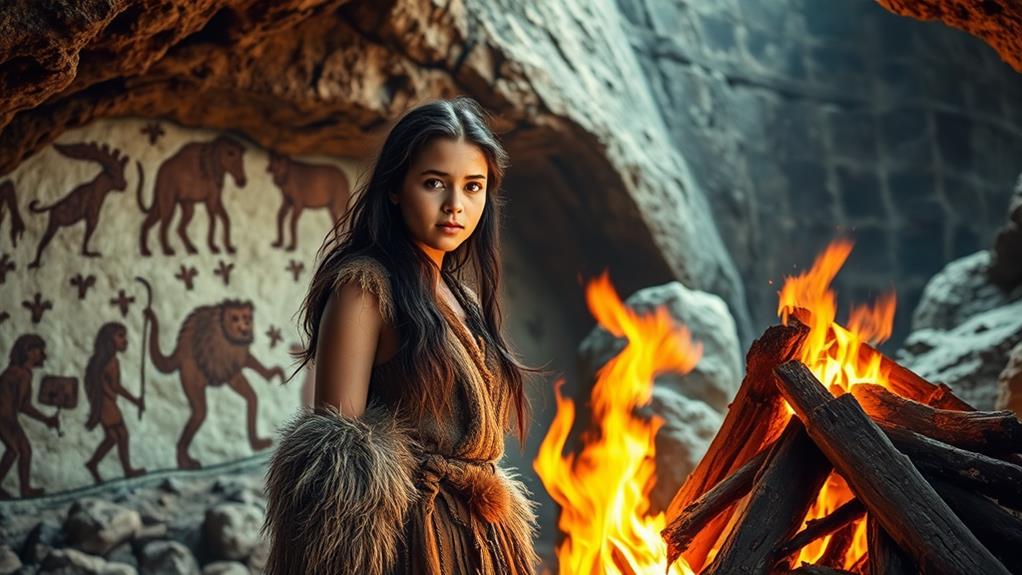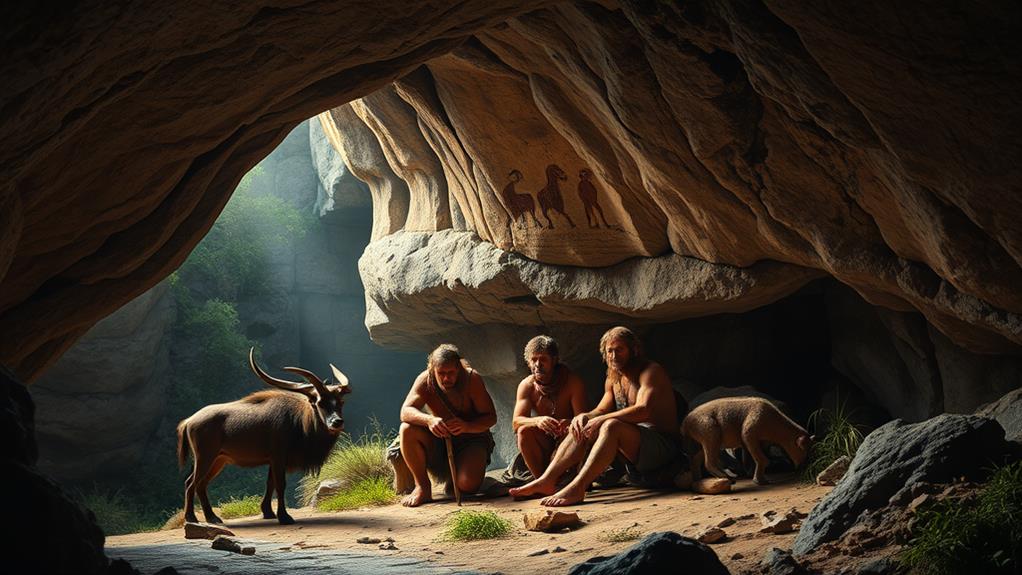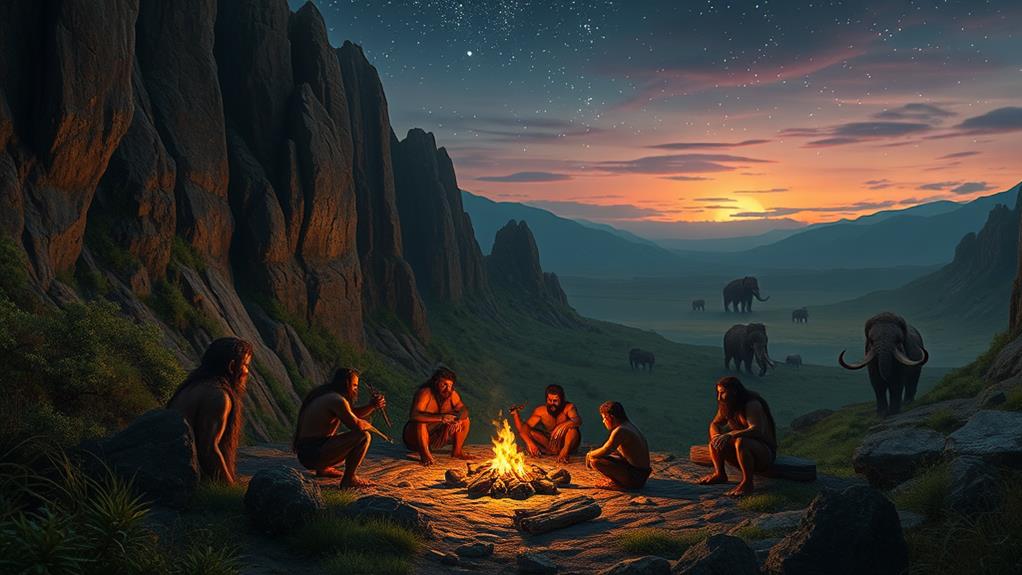In "The Clan of the Cave Bear," you're taken on an extraordinary journey back to the Ice Age, where you meet Ayla, a young Cro-Magnon girl. After losing her family to an earthquake, she's adopted by a Neanderthal clan, facing challenges of identity and belonging. Jean Auel masterfully weaves themes of survival and cultural tension into Ayla's story, showing her struggle against rigid traditions. With rich anthropological insights, the novel captures both the beauty and brutality of prehistoric life. Curious about how Ayla's journey unfolds and the impact of her unique background? There's so much more to explore!
Overview of the Novel
Set against the backdrop of the Ice Age, "The Clan of the Cave Bear" by Jean M. Auel immerses you in a world where survival is a daily struggle. You follow the journey of a young Cro-Magnon girl named Ayla, who becomes orphaned after a devastating earthquake.
As she finds herself adopted by a Neanderthal group known as the Clan, you witness her fierce battle for identity and belonging within a culture that starkly contrasts her own. This narrative echoes the themes of resilience found in stories like Louis Zamperini's survival in WWII, showcasing the strength of the human spirit against adversity.
The novel also invites reflections on the complexities of human relationships, paralleling the intricate historical contexts explored in "Sapiens."
The novel explores the complexities of human relationships and adaptation. Ayla's intelligence and resilience shine as she navigates the rigid traditions of the Clan, which are often resistant to change.
You'll see how her unique abilities challenge the Clan's worldview, highlighting the tension between cultural evolution and the instinct for survival.
Auel's meticulous research into prehistoric life adds depth to Ayla's journey, allowing you to engage with the broader themes of identity and belonging in a prehistoric context.
As you read, you can't help but reflect on the enduring questions of what it means to be human in a world shaped by both nature and culture.
Author's Research and Background
Jean M. Auel's commitment to well-researched prehistoric fiction shines through in "The Clan of the Cave Bear." To accurately portray the interactions between the Clan of Neanderthals and the Cro-Magnon girl, Auel dove deep into library resources and attended archaeological conventions. Her extensive research was considerably influenced by archaeological evidence gathered from sites like the Shanidar cave, which revealed insights into Neanderthal culture and behavior.
Additionally, Auel's focus on the complexities of social dynamics is reminiscent of the intricate plotting found in historical mysteries like The Daughters of Night, where societal challenges are intricately woven into the narrative.
Auel didn't just scratch the surface; she explored the Aurignacian and Gravettian cultures, weaving these elements into her narrative to create a believable setting. By studying the significance of Venus figurines within Cro-Magnon culture, she enriched her story with authentic representations of prehistoric religious practices and beliefs.
Moreover, Auel collaborated with paleontologists and anthropologists, integrating new discoveries about Paleolithic life into her storytelling. This collaboration not only enhanced the credibility of her work but also allowed readers to immerse themselves in a world that feels both realistic and vivid.
Her meticulous attention to detail transforms "The Clan of the Cave Bear" into a fascinating exploration of human history, making it a standout in the genre of prehistoric fiction.
Themes and Character Analysis

The rich research that informs "The Clan of the Cave Bear" sets the stage for a profound exploration of themes and character dynamics. Central to the narrative is Ayla, whose journey embodies survival against overwhelming odds, much like Bigger Thomas in Richard Wright's "Native Son," where the protagonist's struggles highlight the impact of societal pressures.
After losing her family, she adapts to life with the Neanderthal Clan, showcasing her remarkable resilience. This resilience contrasts sharply with the Clan's rigid customs, emphasizing the tension between cultural acceptance and individuality.
Ayla's struggle for identity and belonging is palpable throughout the story. As she navigates her mixed heritage, she faces challenges fitting into a community that often regards her as an outsider, reminiscent of the complexities of power dynamics that reinforce societal divisions.
The character of Broud serves as an antagonist, symbolizing societal fears of change and the importance of tradition. His disdain for Ayla's differences underscores the Clan's reluctance to embrace new ideas.
Through her interactions with the Clan members, you gain insights into the complex social structures and cultural dynamics of prehistoric societies.
Ultimately, Ayla's journey not only highlights her personal growth but also invites reflections on the broader themes of identity, resilience, and the quest for belonging in an unforgiving world.
Reception and Community Feedback
When you explore the reception of "The Clan of the Cave Bear," you'll notice a mix of nostalgia and disappointment among readers. While some cherish the vivid storytelling, others feel let down by modern language and repetitive elements throughout the series.
This divide highlights how different expectations can shape your experience with the narrative, much like the varied experiences of immigrant families in early 20th-century Brooklyn, where struggles and triumphs shaped their stories and relationships the struggles of immigrant communities.
Ultimately, this contrast in perspectives underscores the timeless themes of resilience and personal growth that resonate across different narratives.
Mixed Audience Reactions
Mixed reactions from audiences highlight the divide in how readers perceive "Prehistoric Times."
With an average rating of 4.09 from over 270,000 ratings, it's clear that many are engaged, yet community feedback reveals a notable frustration with the use of modern terminology in a prehistoric setting.
Some readers admire the intricate storytelling and character development, especially regarding the Neanderthal clan dynamics, while others criticize the writing style for excessive exposition that detracts from the narrative.
As you explore the cave of opinions, you'll notice that discussions frequently focus on the interactions between Neanderthals and Cro-Magnons.
This raises questions about historical accuracy versus the needs of the story.
While the first book in the Earth's Children series is often highly regarded, subsequent entries have received more mixed reviews, with some fans feeling that the innovation found in the original has waned.
Nostalgia Vs. Disappointment
Nostalgia often colors readers' perceptions of "The Clan of the Cave Bear," creating a complex tapestry of emotions that intertwine admiration and disappointment. As a bestselling novel in the Earth's Children series, it captures the essence of prehistoric life and deeply resonates with fans. With an average rating of 4.09, it's clear that many of you cherish the characters and their journeys, yet mixed feelings linger.
Community feedback reveals frustrations, particularly with the modern terminology that disrupts the immersive experience of a prehistoric world. You may find excessive exposition detracts from the narrative flow, leading to disappointment.
While the first book garners widespread praise, subsequent entries often fail to deliver the same depth, leaving readers feeling let down.
Discussions surrounding the portrayal of Neanderthals and Cro-Magnon interactions reflect both admiration for the anthropological insights and criticism regarding historical accuracy. Many of you hold on to that nostalgia, fueling interest in adaptations despite past disappointments translating the story to screen.
Ultimately, this blend of nostalgia and disappointment shapes your ongoing relationship with Ayla and her world, illustrating the complex nature of your emotional engagement with this iconic novel.
Adaptations in Film and Television

Adapting prehistoric narratives into film and television presents unique challenges and opportunities for creators. One of the most notable attempts is the 1986 film adaptation of Jean Auel's "The Clan of the Cave Bear," directed by Michael Chapman. While Daryl Hannah's portrayal of Ayla brought a visual interpretation to the screen, critics often pointed out its lack of depth in character development.
Many significant themes from Auel's novel were glossed over or omitted, leaving fans disappointed. The subjective nature of storytelling in adaptations emphasizes the elusive quality of truth, as audiences seek a connection to the deeper truths conveyed through narratives like Auel's the power of storytelling.
In 2014, a pilot episode for a television adaptation was ordered by Lifetime, but it faced a similar fate and was ultimately canceled despite the involvement of notable producers. Various networks have expressed interest in adapting the series, yet none have successfully brought the project to fruition.
This leaves viewers keen for a faithful representation that captures the essence of Auel's work. With modern filmmaking techniques, including CGI, there's potential to illustrate the differences between Cro-Magnon and Neanderthal cultures more vividly.
As interest in "The Clan of the Cave Bear" continues, it raises the question: will we ever see a compelling adaptation that truly honors Auel's vision?
Legacy and Cultural Impact
The impact of "The Clan of the Cave Bear" extends far beyond its pages, shaping how we view prehistoric life and culture. Selling over 45 million copies worldwide, this book established Jean Auels as a leading author in prehistoric fiction.
The novel's exploration of the interactions between Cro-Magnons and Neanderthals has ignited a passion for anthropological studies, influencing your perception of early human life and cultural evolution. Additionally, the themes of survival and identity resonate with contemporary struggles, prompting reflections on personal and societal challenges, similar to the resilience and hope found in Rohinton Mistry's works.
As part of the Earth's Children series, it inspires ongoing discussions about survival, identity, and adaptability, making its themes resonate with you even today. You see the relevance of prehistoric narratives in understanding human nature reflected in contemporary society.
The film adaptation, while receiving mixed reviews, has retained cultural significance, sparking conversations about the challenges of translating literary works to the screen. This ongoing dialogue keeps the book in the spotlight, furthering interest in fields like archaeology and anthropology.
Ultimately, "The Clan of the Cave Bear" has left a lasting legacy, shaping both your understanding of prehistory and the broader cultural landscape, ensuring its place in literary and academic discourse for years to come.
Conclusion
In "The Clan of the Cave Bear," you've journeyed through a vivid prehistoric world, uncovering the struggles and triumphs of its characters. Just like a time machine, the novel transports you back to an era where survival and connection were paramount. You've felt the weight of Ayla's challenges and celebrated her resilience. As you close the book, remember that her story echoes through time, inviting you to reflect on your own place in the tapestry of humanity.



